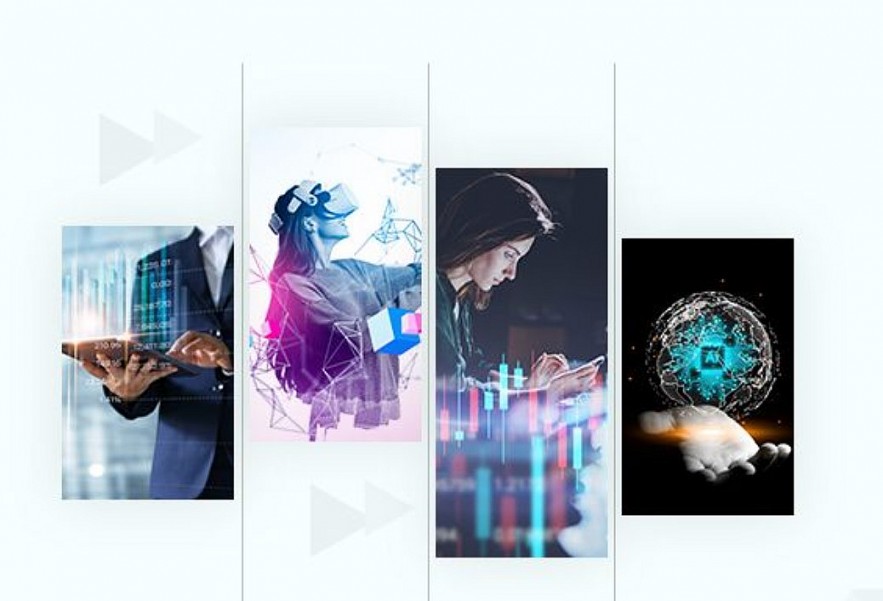Top 20 Most Advanced Technology in the World 2025
Exploring the Frontiers of Advanced Technology
Advanced technology encompasses innovative systems, cutting-edge devices, and groundbreaking methodologies that far exceed traditional counterparts in efficiency, functionality, and complexity. This term applies to the latest breakthroughs across multiple fields, including information technology, biotechnology, nanotechnology, robotics, aerospace, and renewable energy—each pushing the boundaries of scientific and engineering achievements.
In a world where technological evolution moves at an exponential pace, the pursuit of the next revolutionary breakthrough never ceases to captivate global attention. From the astonishing potential of quantum computing to the ever-expanding capabilities of artificial intelligence, humanity remains committed to redefining what’s possible.
Join us as we embark on a journey through the most advanced technological innovations, where science fiction meets reality, and the future unfolds before our eyes. Together, we will delve into the depths of human ingenuity to uncover the extraordinary advancements that define the pinnacle of modern technology.
What is the Most Advanced Technology?Technology-wise, artificial intelligence (AI) is among the most cutting edge available today. Artificial Intelligence (AI) is a vast field that includes many different skills, such as robotics, computer vision, natural language processing, machine learning, and more. It makes it possible for computers to carry out operations that have historically required human intelligence, like identifying patterns in data, comprehending language, coming to conclusions, and even managing physical systems on their own. |
 |
| Most Advanced Technology in the World |
Top 20 Most Advanced Technology in 2025
1. Artificial Intelligence (AI)
As 2025 approaches, artificial intelligence (AI) is continuing to rise spectacularly thanks to the unwavering commitment of scientists and researchers to its development. The quest for more efficient uses of this revolutionary technology has characterized the development of AI theory in recent years. AI is now present in many aspects of society, including digital assistants like Google Assistant, Alexa, Siri, and Cortana. These artificial intelligence (AI) systems perform data analysis, face and speech recognition, and seamless integration into our daily lives, supporting tasks like grocery shopping, exercise tracking, and even medical procedures.
In addition to influencing present trends, AI's pervasiveness paves the way for even more revolutionary advancements in the years after 2025. Furthermore, AI has an impact on a wide range of industries, including healthcare, entertainment, finance, and automobiles. Advanced deep learning and artificial neural networks, in particular, have the potential to completely transform medical practices by enabling professionals to complete cognitive tasks with previously unheard-of speed and accuracy. Notably, the rapidly expanding field of artificial intelligence (AI) offers professionals all over the world lucrative opportunities, with salaries commensurate with the growing demand for knowledge in this cutting-edge field.
2. Internet of Things (IoT)
In the years to come, the vast network of linked devices known as the Internet of Things (IoT) is expected to completely change how we engage with technology. The IoT market is expected to grow rapidly, with estimates indicating that people will own about 20 IoT devices apiece by 2030. IoT applications cover a wide range of industries and include smart watches, refrigerators, cleaning robots, medical devices, water distribution systems, smart bands, and networks for monitoring public safety.
But as the use of IoT grows, worries about identity protection, privacy, and data security are becoming more and more pressing. To stay competitive in an increasingly linked world, businesses operating in the IoT space need to put user safety and security first. This requirement highlights the need for strong cybersecurity protections and proactive risk mitigation strategies, and it applies to both the makers of cutting-edge technology and the devices themselves.
3. Lithium Metal Batteries
The advent of electric vehicles (EVs) that run on advanced lithium metal batteries is causing a rapid transformation in the automotive sector. Touted as a revolution in the automotive industry worldwide, these batteries have multiple benefits over conventional lithium-ion alternatives. Lithium metal batteries are notable for their notable energy density of 1 kWh per liter of capacity, which is nearly twice as high as that of their predecessors.
The introduction of lithium metal batteries, which demonstrate an astounding 80% increase in longevity even after 800 charging cycles, also promises longer charge times and improved longevity. In a historic move, QuantumScape's successful December 2020 lithium metal battery trial opened the door for an innovative collaboration with Volkswagen. According to the agreement, the automotive industry's reliance on conventional fuel sources will undergo a paradigm shift when these batteries are integrated into all-electric vehicles starting in 2025.
4. GPT-3
With its unmatched sophistication and adaptability, Generative Pre-Trained Transformer 3 (GPT-3) marks the beginning of a new era in neural network technology. GPT-3, dubbed the most specialized neural network to date, uses natural language processing (NLP) algorithms to produce contextually rich responses in interactions that resemble those of a human.
With an astounding 100 times more data and parameters than its predecessor, GPT-2, this dynamic neural network has enormous potential for a wide range of applications. However, in spite of its great powers, GPT-3 has certain built-in shortcomings, most notably its heavy reliance on large datasets and processing power for training. Moreover, the pursuit of endowing AI systems with emotional intelligence and sophisticated comprehension is still ongoing, highlighting the dynamic character of this revolutionary technology.
5. Wi-Fi 6 and 5G
The fusion of 5G and Wi-Fi 6 technologies ushers in a new era of connectivity by enabling seamless data transfer and communication between various platforms and devices. Along with the current 2.4 and 5 GHz frequencies, Wi-Fi 6 adds a new 6 GHz frequency band. Users can expect faster internet speeds, more dependable service, and better device connectivity.
Concurrently, the introduction of 5G networks is expected to bring about revolutionary developments in the areas of mission-critical services, IoT scalability, and mobile broadband. With predictions indicating a significant boost to the US economy and job creation in the coming years, businesses can seize previously unheard-of opportunities for remote work, real-time analytics, and economic growth by utilizing these cutting-edge communication standards.
6. Virtual and Augmented Reality (VR/AR)
As more and more applications in various industries emerge, the market for virtual and augmented reality (VR/AR) technologies is still expanding. While gaming is still a common VR/AR use case, by 2025, a shift toward social connection and useful applications is predicted.
More accessibility and adoption of VR/AR technologies are anticipated as their costs come down, especially in the fields of gaming, recreation, architecture, and engineering. Notably, forecasts suggest that the VR/AR glove market will grow significantly over the next several years. VR/AR technologies promise to revolutionize a number of industries, from immersive training simulations to architectural visualization, and to usher in a new era of interactive storytelling and experiential computing.
7. Voice Search and Voice Assistants
Speech recognition and natural language processing (NLP) technologies are developing at a rapid pace, which puts voice search and voice assistants at the forefront of the digital world. Virtual assistants are already more accurate and efficient than traditional text-based searches, which is why major tech companies like Google, Apple, and Amazon are increasing their investments in this emerging field.
Voice search and voice assistants are widely used in a variety of industries, including e-commerce, customer service, healthcare, and education. Consumer preferences for personalized experiences and seamless interactions are driving this widespread adoption. Businesses will profit from improved customer engagement, streamlined operations, and new revenue-generating opportunities as these technologies develop, highlighting their strategic importance in an increasingly voice-centric digital ecosystem.
8. Metaverse
Users can engage in real-time interactions with digital environments and each other in the metaverse, a virtual and interconnected digital universe. To create immersive, shared experiences, it combines virtual reality (VR), augmented reality (AR), and other technologies. Businesses are looking into using the metaverse in a variety of fields, including social networking, education, gaming, and healthcare.
This trend, which unites the digital and real worlds, is anticipated to have a significant impact on business collaboration, communication, and entertainment.
9. Geoengineering
As the stark reality of irreversible climate change sinks in, the need to lessen its disastrous effects grows more pressing. In an effort to avert environmental disasters like superstorms, megadroughts, and rising sea levels, humanity may grudgingly resort to geoengineering. There are many different ideas for geoengineering interventions, from injecting particles into the stratosphere to seeding cirrus clouds to control solar radiation.
In an effort to mitigate the effects of greenhouse gas emissions, these techniques seek to alter Earth's climate systems. Notwithstanding the possible advantages, geoengineering entails considerable risks, such as the possibility of unanticipated outcomes and dependence on such interventions. However, advanced climate modeling and supercomputing technologies may provide crucial insights to guarantee the security and effectiveness of geoengineering tactics as we navigate the complexity of climate change.
10. Mind-to-Mind Communication
Developments in neuroscience and communication technologies have the potential to make humans telepathic. Direct mind-to-mind communication has the potential to strengthen interpersonal bonds and give rise to a collective consciousness resembling a "hive mind."
Though still in their early stages, recent brain-to-brain communication experiments suggest that thoughts may one day be used to telekinetically communicate and control devices. As this field continues to advance, we might see a time when the distinctions between individual minds become less clear, opening the door to a new era of shared cognition and interconnectedness.
11. Digital Twins
Digital twins are virtual replicas of physical objects, processes, or systems. These digital representations are generated using data from sensors, IoT devices, and other sources. Digital twins allow organizations to closely monitor, simulate, and analyze real-world assets and operations within a virtual environment.
They have a wide range of applications in manufacturing, urban planning, healthcare, and other industries. Through the use of digital twins, companies can streamline operations, make more informed choices, and boost effectiveness, security, and eco-friendliness.
 |
| New Technology Trends for 2024/2025 |
12. Fusion Power
In the quest for clean and abundant energy sources, nuclear fusion emerges as a highly promising avenue. Recent experiments, such as heating low-density hydrogen plasma to 80 million degrees Celsius, mark important advancements in the field of fusion energy.
Unlike nuclear fission, where atomic nuclei are split, fusion combines nuclei to release immense amounts of energy. Nevertheless, the task of achieving controlled fusion reactions presents significant obstacles, such as the containment of plasma and the extraction of energy. Despite the challenges, fusion power has the potential to completely transform energy production and reduce our dependence on fossil fuels, providing a sustainable solution to our energy requirements.
13. Robotic Process Automation (RPA)
Similar to AI and Machine Learning, Robotic Process Automation is a technology that streamlines and automates various tasks. Software automation streamlines business processes, including application interpretation, transaction processing, data management, and email responses. RPA streamlines and automates repetitive tasks that were previously performed by individuals.
Forrester Research has estimated that RPA automation will have a significant impact on the global workforce, potentially affecting the livelihoods of millions of knowledge workers. However, it's important to note that RPA is also generating new job opportunities and transforming existing roles. According to McKinsey's analysis, a small fraction of occupations, less than 5 percent, can be fully automated. However, a significant portion, around 60 percent, have the potential for partial automation.
14. Edge Computing
Once considered a cutting-edge technology, cloud computing has now become a widely adopted solution, with industry leaders like AWS (Amazon Web Services), Microsoft Azure, and Google Cloud Platform leading the way. Cloud computing continues to gain popularity, with an increasing number of businesses opting for cloud solutions. However, it is no longer the latest technology trend. It is.
Just as organizations are grappling with the ever-growing amount of data they handle, they have come to acknowledge the limitations of cloud computing in certain scenarios. Edge computing offers a solution to the challenges posed by cloud computing and the delays caused by transferring data to a central processing facility. It has the potential to exist in a more strategic position, closer to where computing needs to take place. Due to this reason, edge computing can be utilized to handle time-sensitive data in remote areas that have limited or no connectivity to a centralized location. During such scenarios, edge computing functions as small-scale datacenters.
15. Quantum Computing
Quantum computing, or computing that makes use of quantum phenomena like superposition and quantum entanglement, is the next big technological development. Because of this incredible technological trend's ease of querying, monitoring, analyzing, and acting upon data from any source, it is also helping to stop the coronavirus from spreading and to develop possible vaccines. Quantum computing is also being used in the banking and finance industry for fraud detection, high-frequency trading, and credit risk management.
Large companies like Splunk, Honeywell, Microsoft, AWS, Google, and many more are currently involved in making innovations in the field of Quantum Computing. Quantum computers are currently a multitude of times faster than conventional computers. By 2029, the global market for quantum computing is expected to generate more than $2.5 billion in revenue. Additionally, knowledge of quantum mechanics, linear algebra, probability, information theory, and machine learning are prerequisites for success in this new, in-demand field.
16. Virtual Reality and Augmented Reality
Virtual reality (VR), augmented reality (AR), and extended reality (ER) represent the next great technological trend. While AR improves the user's surroundings, VR immerses the user in it. Up until now, this technological trend has mostly been utilized for gaming, but it has also been used for training. For example, VirtualShip is a simulation program that is used to teach ship captains in the U.S. Navy, Army, and Coast Guard.
We can anticipate a greater integration of these technologies into our daily lives in 2024. Virtual reality (VR) and augmented reality (AR) have a lot of applications in marketing, education, training, entertainment, and even injury recovery. They typically work in concert with some of the other cutting-edge technologies we've covered in this list. These could be applied to improve theme parks, give visitors to museums a more immersive experience, teach medical professionals how to perform surgery, or even improve marketing, like in the case of this Pepsi Max bus shelter.
While some employers may require optics as a skill set, keep in mind that starting a career in virtual reality (VR) doesn't require a lot of specialized knowledge. Anyone with a forward-thinking mindset and a basic understanding of programming can land a job in VR, which is another reason this new technology trend should be on your radar!
17. Blockchain
While most people associate blockchain technology with cryptocurrencies like Bitcoin, blockchain provides security benefits in numerous other domains. To put it simply, blockchain is just data that you can add to, not take away from or modify. Since you are creating a chain of data, the term "chain" makes sense. What makes it so secure is that the previous blocks cannot be changed. Furthermore, since blockchains are consensus-driven, no single party is able to seize control of the data. Blockchain eliminates the need for transaction oversight and validation by a reliable third party.
Blockchain technology is being used in a number of industries, and as its application grows, so does the need for qualified personnel. From an aerial perspective, creating and executing blockchain-based architecture and solutions is the area of expertise for blockchain developers.
18. Cyber Security
Given that it has been around for a while, cyber security may not seem like a new technological trend, but it is still developing along with other technologies. This is partially due to the ever-evolving nature of threats. Malevolent hackers who are attempting to obtain data illegally are not going to give up easily, and they will keep finding ways around the most robust security measures. Additionally, some of it stems from the adaptation of new technology to improve security. Because cybersecurity will always be advancing to fend off hackers, it will continue to be a hot topic in technology.
By 2025, 60% of businesses will use cybersecurity risk as their main consideration when entering into business agreements and dealing with third parties, predicts Gartner.
19. DevOps
DevOps emphasizes the importance of teamwork and effective communication between software development and IT operations teams. It seeks to automate and streamline the software development and deployment lifecycle, enabling more frequent and dependable releases. DevOps practices encompass continuous integration, continuous delivery, infrastructure as code, and automated testing. Embracing DevOps results in accelerated development cycles, enhanced software quality, and increased adaptability to changes and customer requirements.
20. 3D Printing
Using 3D printing to create prototypes is a major innovation and technological trend. This technology has had an impact on both the industrial and biomedical fields. While printing a real object from a printer is a reality today, none of us ever considered doing so. Thus, another innovation that is here to stay is 3D printing. Many jobs pay well and are international for companies in the data and healthcare sectors that need a lot of 3D printing for their products. All you really need to know is the fundamentals of 3D printing, modeling, AI, and machine learning.
In Conclusion: Shaping the Future: Innovation with Purpose
Our journey toward a future driven by extraordinarily advanced technologies is not just about breakthroughs and innovation—it is also about the values, aspirations, and shared wisdom that guide us. As we navigate this ever-evolving landscape, our mission must be to harness technology for positive change, unlock new opportunities, and build a future that is more inclusive, hopeful, and sustainable for generations to come.
The pace of technological evolution is accelerating, enabling rapid progress and transformation. However, it is not just emerging technologies and trends that are shifting—the very role of IT professionals is undergoing a fundamental change. In the digital era of 2024 and beyond, technology experts must embrace a mindset of continuous learning, unlearning, and relearning, adapting not just by choice but out of necessity to keep pace with a rapidly evolving, contactless world.
While technological progress is undeniably exciting, we must approach it with humility, foresight, and responsibility. The future depends on our ability to leverage innovation ethically, ensuring that advancements benefit both humanity and the planet. By fostering cross-disciplinary collaboration, prioritizing sustainability, and championing equity, we can navigate the complexities of this technological revolution and build a resilient, prosperous future for all.
 Top 10 Most Popular Social Media Trends in 2024 to Follow Top 10 Most Popular Social Media Trends in 2024 to Follow As technology advances, it is crucial for both individuals and businesses to comprehend and effectively utilize social media trends in order to maximize their marketing ... |
 Top 10 Emerging IT Trends That Will Rule The World 2024 Top 10 Emerging IT Trends That Will Rule The World 2024 Let's dive into the emerging IT trends in 2024 to see which tools and technology will rule our world in the future. |
 Top 10 Emerging Education Trends In 2024 Worldwide Top 10 Emerging Education Trends In 2024 Worldwide Education trends are changing as technology advances. Educators must stay current on developing advances in education technology to guarantee that their students have the best ... |
 Top 10 Biggest AI Trends To Dominate The World 2024 Top 10 Biggest AI Trends To Dominate The World 2024 Machine learning and artificial intelligence (AI) will drive substantial progress by 2024. Check out the Top 10 Biggest AI Trends That Will Rule The World ... |
























